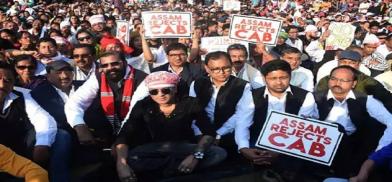Assam: Betrayed by politicians, united strongly in anti-CAA protest
The issue of illegal immigrants, from Bangladesh to be precise, is, therefore, an old wound for the Assamese people. For someone familiar with the geography of the state, the changing demography is hard to miss, writes Azera Parveen Rahman for South Asia Monitor

The Indian capital has taken centre-stage again. From Jamia Millia Islamia some weeks ago, to Jawaharlal Nehru University (JNU) now, as students stand in the midst of a raging fire, volcanic eruptions of support are bursting through campuses across the country. Through the eyes of the media—social media included—it is apparent how people have come on to the streets to express solidarity with the students. The anti-Citizenship Amendment Act (CAA) protests are continuing to burn bright.
But in this kaleidoscopic view of the country that even the international media is talking extensively about, a fog has settled beyond the ‘chicken’s neck’. That part of the map which is connected to the rest of India through a thin piece of land—Northeast India—is again lost from the headlines and from the collective vision of the rest of the country. Assam, mind you, is continuing to protest vehemently against the CAA. Other states of the Northeast are protesting too, but the voices are louder from Assam. It is, in fact, in Assam where the first flame of protest went up when the Citizenship Amendment Bill was going to be introduced in the Parliament. Through the last few weeks of bitter cold and very bitter memories of young lives snuffed out during these protests, through curfews and internet suspension, the people of Assam have continued to protest, using not just sloganeering on the roads, but also through art and music as a medium. But it’s a lonely battle.
Barring those in the region, #IStandwithAssam has long dropped from trending on twitter and the mainstream media doesn’t have space for it anymore. It barely did anyway, except when there were episodes of violence or during the devastating floods every year—but let’s save that apathy for another time. The main reason why, despite roaring aloud against the CAA like the rest of the country, Assam still stands alone is that its cause does not align with the expected narrative of the Hindu-Muslim binary. Its fight is not focused on the exclusion of a particular community, but against every illegal immigrant who set foot in Assam after 1971, as per the Assam Accord—religion no bar.
For those of my parents’ generation, the current struggle in Assam is a reminder of the Assam Agitation of the 1980s. The issue was the same: no more illegal immigrants in Assam. Those standing at the forefront of that struggle—between 1979-85—were the same: students. Seventeen-year-old Sam Stafford, who died after sustaining a bullet injury during the anti-CAA protests last month, is hailed as a martyr, just like 22-year-old Khargeshwar Talukdar of the All Assam Students Union (AASU) was. Kalita was the first of the 855 martyrs of the Assam Agitation.
The issue of illegal immigrants, from Bangladesh to be precise, is, therefore, an old wound for the Assamese people. For someone familiar with the geography of the state, the changing demography is hard to miss. For how long should the Assamese people continue to share their land and resources? The ‘fear’ of dilution of the Assamese identity—its culture, its language—and being reduced to a minority in its own homeland is a palpable fear. The Congress was often blamed for twiddling its thumbs on the issue and finally thrust out of power for the BJP (with the Asom Gana Parishad or AGP as an ally), which promised to deal with this long-standing issue. With the CAA, the ruling BJP and its leaders have stabbed the Assamese people in the back.
This time, therefore, and despite some terming these protests as Assam Agitation 2.0, the anger is simmering much more. What can one hope for from the mainlanders (read, the BJP in power at the Centre) when your own (the State representatives) have betrayed you? Assam Chief Minister Sarbananda Sonowal began his political journey as president of the AASU, which had led the Assam Agitation against illegal immigrants for years. The AGP, which had long spoken against illegal immigrants, has also betrayed the people.
This betrayal has, however, unified the people. There are Hindus and Muslims, Assamese-speaking and Bengali-speaking, Adivasis and others, standing together in these protests. In most places, these have been organic, with no ‘organisation’ taking the lead. Well-known singers and actors of the state have come out in full support. Social media is abuzz with news and updates about protests from different parts of the state. Youngsters are disillusioned with the current political leadership—either of the BJP or the Congress. Both didn’t stand by the Assam Accord which had set 1971 as the year until when anyone coming or staying in Assam is considered an Assamese. Youngsters are motivated to take matters in their own hands and are thinking aloud along the lines of a new regional party.
Assam has disappeared from the national headlines but hundreds of people are continuing their dharnas (sit-ins) and protests, peacefully and in full force, in different parts of the state. It will be a long journey but those on the roads know there’s no turning back now.
(The writer is an award-winning journalist)













Post a Comment